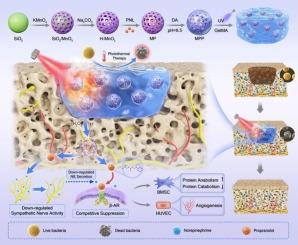Propranolol-loaded multifunctional hydrogel enhances the repair of infected bone defects via sympathetic microenvironment remodelling
IF 13.2
1区 工程技术
Q1 ENGINEERING, CHEMICAL
引用次数: 0
Abstract
Infected bone defects pose a major challenge in orthopaedics, requiring simultaneous infection control and bone regeneration. Pathogen colonization initiates immune responses and acidic metabolite secretion, which suppress osteoblast function and may induce tissue necrosis. Meanwhile, traumatic injury activates systemic and local stress responses, leading to sympathetic overactivation and catecholamine accumulation in the defect area, further hindering bone repair. To address these issues, we developed a photosensitive gelatin methacryloyl (GelMA) hydrogel incorporating polydopamine (PDA)-coated hollow manganese dioxide (hMnO2) nanoparticles loaded with propranolol (PNL), termed GMPP hydrogel. Under near-infrared light, GMPP generates photothermal effects that effectively kill Staphylococcus aureus and Escherichia coli. In the acidic infection microenvironment, propranolol is released, counteracting norepinephrine-mediated inhibition of angiogenesis and reducing excessive sympathetic nerve activity. Moreover, propranolol mitigates catabolic protein metabolism driven by sympathetic stress, thereby accelerating osteogenesis. Animal studies reveal that infected bone defects exhibit heightened and prolonged sympathetic activity compared to non-infected sites, while GMPP significantly promotes bone regeneration in infected cranial defects in SD rats. This study introduces a novel approach that integrates antibacterial therapy and neuromodulation, highlighting the importance of neural microenvironment remodelling in treating infected bone defects and advancing bone tissue engineering strategies.

普萘洛尔负载的多功能水凝胶通过交感神经微环境重塑增强感染骨缺损的修复
感染性骨缺损是骨科面临的主要挑战,需要同时控制感染和骨再生。病原体定植引发免疫反应和酸性代谢物分泌,从而抑制成骨细胞功能并可能诱导组织坏死。同时,创伤性损伤激活全身和局部应激反应,导致交感神经过度激活和儿茶酚胺在缺损区积聚,进一步阻碍骨修复。为了解决这些问题,我们开发了一种光敏明胶甲基丙烯酰(GelMA)水凝胶,其中含有聚多巴胺(PDA)涂层的中空二氧化锰(hMnO2)纳米颗粒,并装载了心得安(PNL),称为GMPP水凝胶。GMPP在近红外光下产生光热效应,能有效杀灭金黄色葡萄球菌和大肠杆菌。在酸性感染微环境中,释放心得安,抵消去甲肾上腺素介导的血管生成抑制,减少过度的交感神经活动。此外,心得安可以减轻交感神经压力引起的分解代谢蛋白代谢,从而加速成骨。动物研究表明,与未感染部位相比,受感染的骨缺损表现出更高和更长时间的交感神经活动,而GMPP可显著促进SD大鼠受感染颅骨缺损的骨再生。本研究介绍了一种结合抗菌治疗和神经调节的新方法,强调了神经微环境重塑在治疗感染性骨缺损和推进骨组织工程策略中的重要性。
本文章由计算机程序翻译,如有差异,请以英文原文为准。
求助全文
约1分钟内获得全文
求助全文
来源期刊

Chemical Engineering Journal
工程技术-工程:化工
CiteScore
21.70
自引率
9.30%
发文量
6781
审稿时长
2.4 months
期刊介绍:
The Chemical Engineering Journal is an international research journal that invites contributions of original and novel fundamental research. It aims to provide an international platform for presenting original fundamental research, interpretative reviews, and discussions on new developments in chemical engineering. The journal welcomes papers that describe novel theory and its practical application, as well as those that demonstrate the transfer of techniques from other disciplines. It also welcomes reports on carefully conducted experimental work that is soundly interpreted. The main focus of the journal is on original and rigorous research results that have broad significance. The Catalysis section within the Chemical Engineering Journal focuses specifically on Experimental and Theoretical studies in the fields of heterogeneous catalysis, molecular catalysis, and biocatalysis. These studies have industrial impact on various sectors such as chemicals, energy, materials, foods, healthcare, and environmental protection.
 求助内容:
求助内容: 应助结果提醒方式:
应助结果提醒方式:


